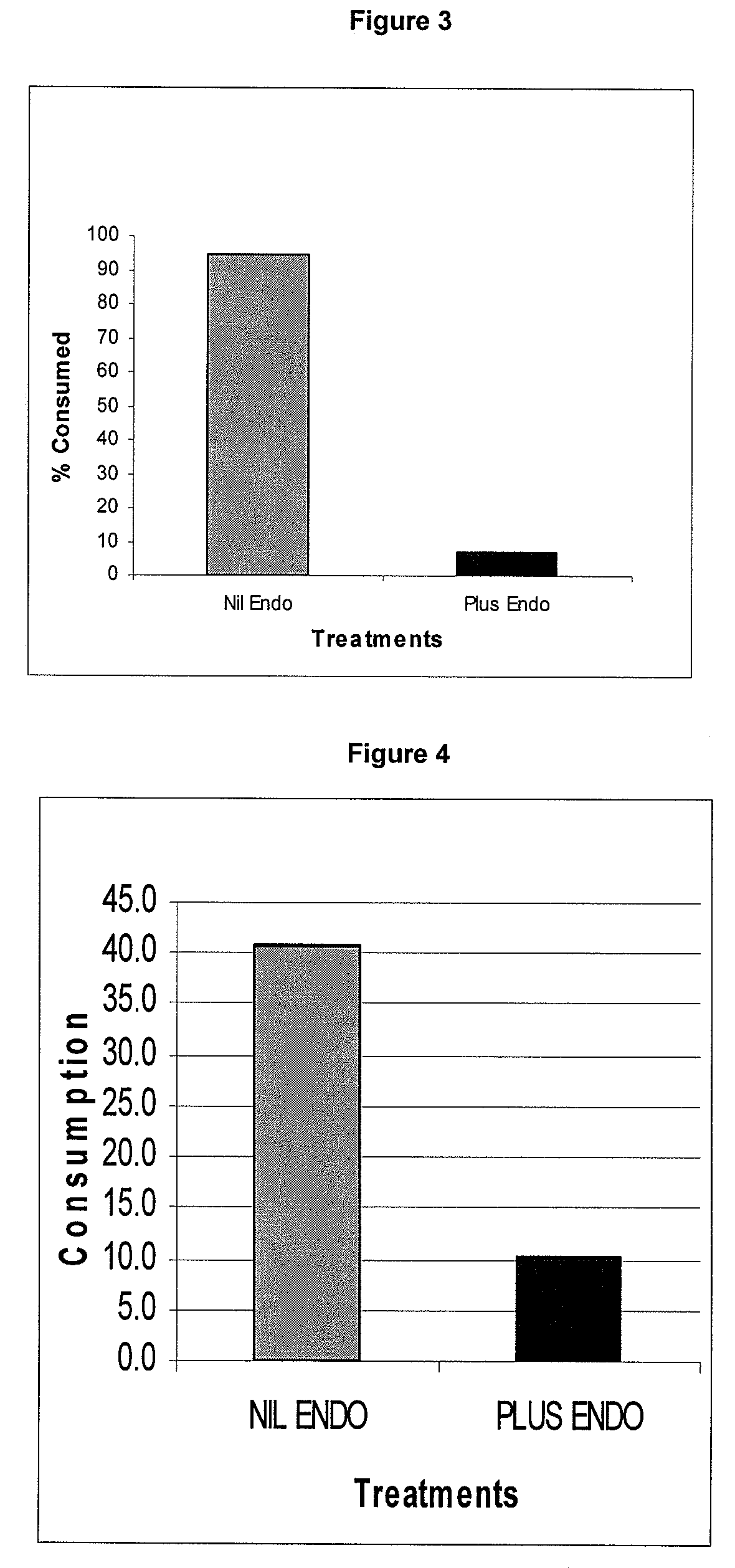Grass based avian deterrent
a technology of avian deterrent and grass, which is applied in the field of grass-based avian deterrent, can solve the problems of unsatisfactory avian populations, severe damage to aircraft, and bird populations can quickly destroy fruit crop(s) and other problems, and achieve the effect of reducing grazing scores
- Summary
- Abstract
- Description
- Claims
- Application Information
AI Technical Summary
Benefits of technology
Problems solved by technology
Method used
Image
Examples
example 1
Seed, Cafeteria Choice Trial
[0112]The inventors ran a series of ‘cafeteria choice trials’ where the gaggle of approximately 20 geese chose between (i) seed without endophyte infection (Nil-endophyte); or (ii) seed that had been inoculated with endophyte A; or (iii) seed that had been inoculated with endophyte B. This tested the PDF and learnt behaviour of post digestion feed back in geese in seed feeding trials.
Seed and Endophyte Combinations Tested
[0113]Three different seed and endophyte combinations were tested during this experiment. The seed from the perennial ryegrass cultivar, Kingston, was inoculated with either endophyte A (Wild Type) or with endophyte B (Endosafe AR5).
[0114]Therefore, the three different seed and endophyte combinations that were tested consisted of:[0115](i) Kingston seed without endophyte (Nil-Endophyte);[0116](ii) Kingston seed inoculated with Endophyte A (Wild type endophyte); and[0117](iii) Greenstone seed inoculated with Endophyte B (AR 5 endophyte).
Ru...
example 2
Herbage, Choice Trial
[0124]In this trial, the methodology used was of similar manner to that of Example 1. The main difference in this trial was that the geese were fed on herbage rather than seeds.
[0125]During this trial, 20 naïve geese that had no exposure to any endophytes were confined to an area of an approximate size of 15 m2. Within this area, perennial ryegrass herbage known as ‘Grasslands Nui’ (Nui) was grown and random sections (of an approximate size of 0.5 m2) of the grass were either infected with AR1 endophyte or not infected at all (nil-endophyte). Each of these plots was randomly distributed within the larger area and cut to ground level.
[0126]The geese were exposed to a number of areas of the same approximate size as detailed above and were only moved when the grass levels where significantly reduced or fouled. After 10 days of geese exposure to the grass areas, the amount of herbage consumed was assessed. As shown in the graph of FIG. 4, the geese consumed approxim...
example 3
Herbage, NO Choice Trial
[0127]A similar trial as described in Example 2 was conducted to assess the amount of herbage a gaggle of geese would consume when the geese were put onto a no-choice diet.
[0128]In this trial, two groups of four naïve geese were confined to cages of 1 m by 3.5 m. The geese were then put onto a diet of nil endophyte Nui ryegrass for a period of eight days. Following this, the geese were then moved to a section of Nui ryegrass that had been infected with AR1 endophyte, also for an eight day period. Post grazing samples of the amount of herbage consumed were taken and assessed.
[0129]As shown in FIG. 5 the average amount of dry weight consumed per day of plant material containing nil endophyte was approximately 20 g. This was in comparison to the 5 g of plant martial consumed that was infected with endophyte. Also shown in FIG. 6, during the eight-day consumption period on the endophyte infected plant material, the geese experienced a weight loss of approximately...
PUM
| Property | Measurement | Unit |
|---|---|---|
| temperatures | aaaaa | aaaaa |
| temperatures | aaaaa | aaaaa |
| time | aaaaa | aaaaa |
Abstract
Description
Claims
Application Information
 Login to View More
Login to View More - R&D Engineer
- R&D Manager
- IP Professional
- Industry Leading Data Capabilities
- Powerful AI technology
- Patent DNA Extraction
Browse by: Latest US Patents, China's latest patents, Technical Efficacy Thesaurus, Application Domain, Technology Topic, Popular Technical Reports.
© 2024 PatSnap. All rights reserved.Legal|Privacy policy|Modern Slavery Act Transparency Statement|Sitemap|About US| Contact US: help@patsnap.com










